



“You Are Now the Electronic Man” are the words that appear before even opening the website for The Electronic Man, a project initiated by Salvatore Iaconesi and Oriana Persico of Art is Open Source (AOS) and FakePress. And by becoming part of The Electronic Man, sharing your emotions as they become linked through QR Codes and help to build the frame of The Electronic Man, you are participating in a real time global performance.
This real time global performance relates to conceptual experiments by AOS and FakePress, in remixing reality and creating new sensual experiences with technology. The email interview took place after their recent exhibition at Furtherfield’s gallery in London, called REFF – REMIX THE WORLD! REINVENT REALITY!, which happened during February, March 2011, and during their current project The Electronic Man. We discuss AOS’s ideas and intentions, regarding their activities of performance and use of technology, and their methods of engagement with anthropology and biology.
Renee : The Electronic Man is quite an ambitious project. What inspired you to begin building the Electronic Man?
Salvator and Oriana: The Electronic Man is actually a very simple project (if quite a difficult one in terms of “making it happen”) as it is a direct poetic interpretation of a theory by Marshall McLuhan that goes by the same name. We decided to take the famous statement by Marshall McLuhan quite literally and transform it into something that is really happening in the world: “Electronic man like pre-literate man, ablates or outers the whole man. His information environment is his own central nervous system.”
What we wanted to do was to make our statement for the centennial of McLuhan’s birth, but to avoid the form of the “conference presentation” for it, and to show in a powerful way how the ideas expressed by McLuhan are really taking place in the world which we experience every day. So we decided to produce a performance, a global performance.
With the wonderful support of Derrick de Kerckhove, and of the MediaDuemila magazine (and the Associazione Amici di Media Duemila and the Osservatorio Tuttimedia, and the Department of Communication and Social Research of Rome’s University “La Sapienza”, who were organizing the official event for the centennial in Rome, under the fundamental guidance of Maria Pia Rossignaud) we were able to make it happen and everyone involved was really happy to include this experience in the official celebrations.
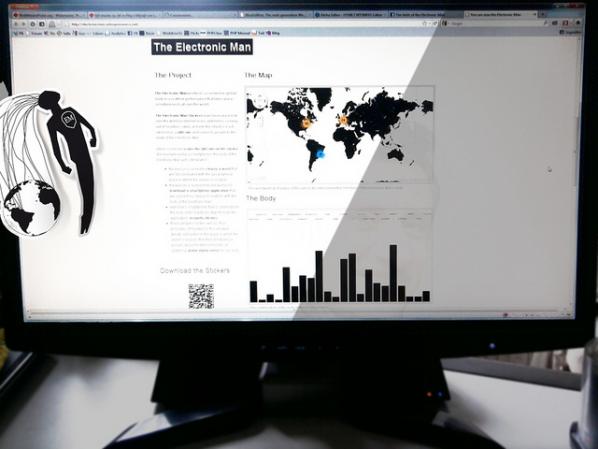
Renee Carmichael: I find the methodology behind this project really interesting. From what I understand it’s about going beyond the analogue vs. digital debate and really going in between and just experiencing and experimenting. Do you think this methodology is important to use in today’s world? How and why might this be so?
Salvatore and Oriana: We are living in a really complex scenario, complex, fast and ever changing. Digital technologies and networks are starting to pervade our analogue reality, transforming it and opening up entirely new possibilities. There are forms of (digital) interaction that are starting to be widely accessible from physical space. These forms of interaction are really peculiar as they allow for a transformation of (physical) reality, making it interactive, reinventing it, remixing it, and adding content to it. The world itself becomes a performance and a very specific form of performance: involving remixes, mashups, recontextualizations and reenactments as its main practices. This has drastic effects, not only as our reality multiplies and reshapes, but also attitudes, perceptions, skills, knowledge and approaches of the people involved change. In this process methodologies, practices and theories remix as well, bringing forth various possible scenarios, in which collaboration practices emerge as the only viable way to perform significant actions.

So, in this scenario, “life, the world and everything” is turning into a multipliable, performative environment in which the only way to, actually, perform in a significant way is to collaborate across cultures, skills, theories and methodologies. This brings forth a change to our sensorial environment, meaning that when ubiquitous technologies are involved, we instantly gain new senses, new sensorialities and sensibilities. Just like with the mobile phone, when it doesn’t catch the network, we move, naturally and without thinking about it, to a place that has better network coverage, in a way that is neurologically similar to the way in which we move our hand away from fire when we feel the heat: it is a real sensibility, an additional sense.
Mixing these two aspects (the forming of a multilayered, collaborative, read-write reality, and the emergence of these new senses), describes a situation that is almost exactly the one presented in the question: experimentation, as in performance and as in science, this new science that traverses disciplines, theories and approaches; and experience, meaning you are actually able to build a new experience of the world that is sensorial and, most important of all, writable.
This is also a good description of the shape that the term “conflict” is assuming: a continuous process of movement and traversal, in which you transform a part of reality (as in augmented reality) adding new meaning and imaginaries to it, in a performative action that unites activism, art, science, design and communication, and that transforms and is transformed really fast, at the pace of the evolution of technologies and networks.
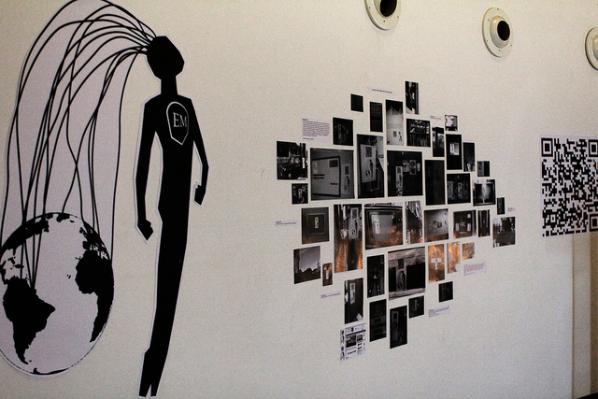
Renee: I read that this project can help us experience and reflect on our place in the world through the external. Do you think the relationship between the individual and the external takes a new shape throughout this project? How might it be understood in the larger ideas and theories of the Electronic Man?
Salvatore and Oriana: The Electronic Man is about the observation and exemplification of something that is already happening in the world. It speaks about interconnection and our renewed perception of space, time, body and relationships. Technologies helped us reshape these concepts completely. We are never in a single place now; we are everywhere, anytime and with lots of people all at the same time, using multiple identities, both voluntarily (mobile phones, ubiquitous networks..) and involuntarily (CCTV, social networks spying on us..). So all these definitions change radically: private and public space, gender, relationship, message, privacy, work and free time. We wanted to make this change explicit. In this change: public and private completely restructure! This is also why we decided to use the “emotional” dimension as a narrative: emotions are thought to be a private, intimate part of our lives, but now they are the object of public observation through what we do in the digital realms, for the new forms of economies that are developing, focusing on attention, reputation, awareness and more.
Renee: Although the Electronic Man allows us to experience sensually, it still creates finite points of data through the connections between a place and an emotion. What do you think is the relationship between the sensual impact of the project and the data it produces? How does the data fit into the idea of creating a new ‘global digital sense of our bodies’?
Salvatore and Oriana: This is a very complicated question! We chose this approach as a starting point. We are using a classification of emotions which is very basic (designed by Plutchik in 1980) it works really well across different languages (we are currently using 29 languages for our performances, to address as much of the world as possible). But this point that is described in the question (freeing the modalities of data, augmenting the degrees of freedom which we can express) is one of the focal points for expansion in the next steps. There are solutions and approaches which we are finding suitable to confront these issues with, and they are all related to adding degrees of freedom in what you “release to the public”: transforming artworks into free frameworks for expression that can be freely used by people. This transformation from artwork to framework is something that is happening all over, and it has to do with P2P culture and free software. This is why we release all the software and hardware (and methodologies) we use in our performances under free licenses: because the next step of each performance is made by the people taking the tools in their own hands and creating their own forms of expression and action, their own additional layers of the world.
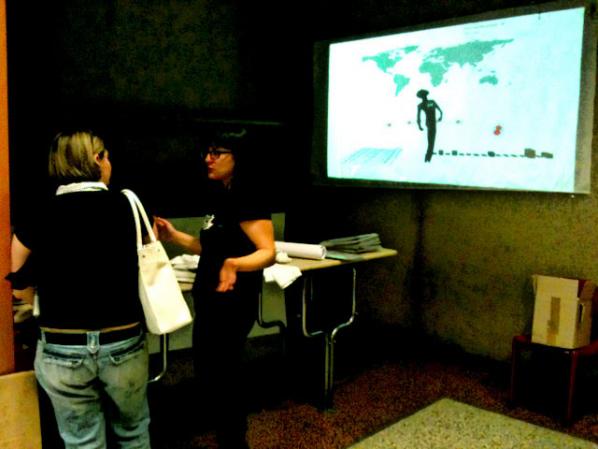
Renee: In a related note, this new form of being that the Electronic Man creates cannot be completely separated from the world and systems it exists in already. It seems that the questions that often arise around this project are in terms of how it can be used within other appropriations. How do you see the future of this project in terms of the various appropriations that it may have and in terms of your own intentions for the project?
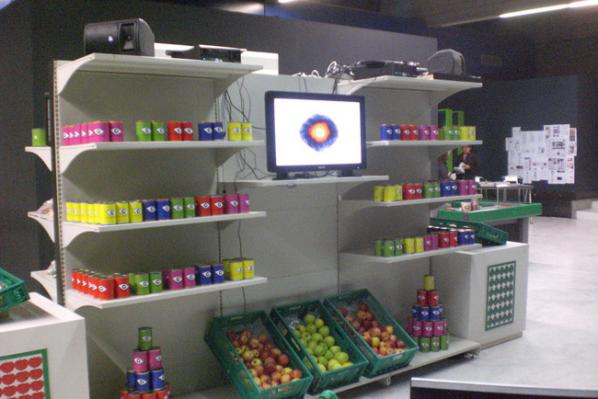
Salvatore and Oriana: As we said: we’re always in beta version. These processes are nomadic, temporary, and unstable. Ideas, software tools, concepts, hardware, practices and approaches are in a continuous state of remix: each time we speak to anyone, or even as we’re writing this, the performance changes and upgrades to the next version. For example we can look at the recent augmented reality interventions that have been taking place all over the world and, just a few days ago at the Venice Biennale: there has been a very fertile discussion building up during the last two years, on the idea that these technologies allow you to “squat” reality, and add new meanings and new degrees of freedom to it. This is why we created a project called Squatting Supermarkets a couple of years ago. This discussion is producing actions: appropriations, performances, re-usage of terms, words, sentences, new forms of activism, and new forms of art. We’re really happy that this is taking place, and we see all this as a wider form of performance in which everyone interested can be involved.
Renee: I can’t help but see a relationship between The Electronic Man and a sort of modern day Frankenstein. Would you like to comment on this relationship?
Salvatore and Oriana: We will answer this question using an answer that our dear friend prof. Massimo Canevacci gave to a question during a TV show in Italy: “This is a wonderful question, and I am deeply convinced that western cultures produced these really heavy mythologies around Frankenstein, the Golem, and arriving to a movie, a very nice one, like Blade Runner, taken from a novel by Philip Dick.
I am certain that this system, this dualism between technology and body, between organic and inorganic, between nature and culture, is finally over, in a liberating way. There are researches in which the concept of cyborg constitutes a perspective that is capable of liberating enormous possibilities. Therefore our bodies become progressively more entangled with technology all over literature, technology, anthropology, and biology.
Thus I sincerely hope that this enormous mythology, this terrifying myth of the Frankenstein, will finally end, once and for all, and will peacefully retire; and that new forms of cyborg will emerge and free themselves, to produce new free forms of expression.
Renee: Finally, any further issues, ideas, thoughts you would like to add?
Salvatore and Oriana: Yes!
The Electronic Man is a global performance! And it becomes useful if lots of people participate (and, by the way, participate by doing even simple things such as attaching some of the Electronic Man stickers around and sending us a picture, and you’ll find yourself and your work advertised whenever we exhibit the work: for example at the MACRO museum in Rome there is a full wall dedicated to the people that are helping us out, including their bios, pictures and links) But, most of all, it becomes useful if lots of people actively grab technologies, methodologies and concepts and actively build their own performative world, possibly sharing the results with everyone else.
So we strongly invite everyone out there to request the software, (it will be published on our sites as soon as we have some time to prepare a proper sharing mechanism, but you all can have it before that by simply asking) and to imagine other disruptive ways of using technologies to create free, accessible, inclusive spaces for communication and expression.
We will support you all in that as much as we can.
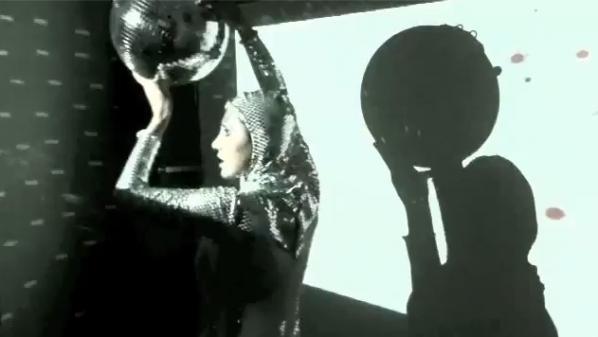
The Electronic Man at ADD Festival, MACRO Testaccio, Rome contemporary art museum, view video on Youtube.